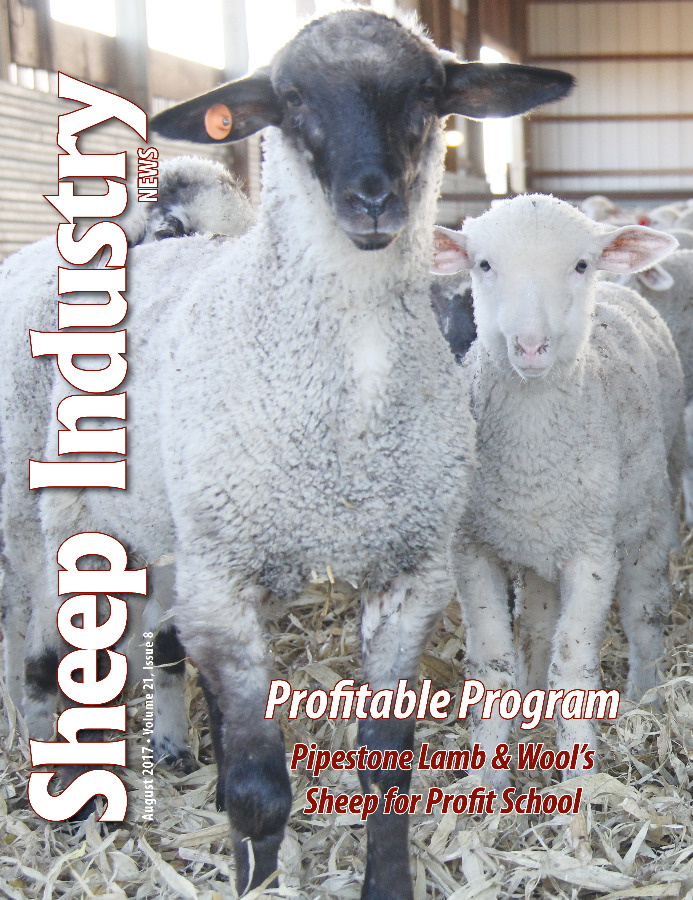To View the August 2017 Digital Issue — Click Here

American Wool & Lamb in the Global Marketplace
Mike Corn, ASI President
ASI prepared trade information for sheep leaders to present at an agriculture summit in Texas last month, and I thought it would be of interest to you.
We essentially operate in a global market for much of the wool and lamb prices we receive. American wool has been subject to issues halfway around the world for decades, whether it be Australian production or textile sales in Europe. Currency exchange rates have had huge impacts on our wool prices for many years. I believe American lamb is a much more global market today, at least for the traditional market with retail chains. Australian and New Zealand supplies and pricing factor in more and more, in my opinion.
A great example is 2011. A spring storm killed a million lambs in New Zealand and shorted their shipments to the United States, which resulted in over optimism in prices paid for lambs here that fell apart in 2012. Similarly, foreign lamb that piled up in United States coolers in recent years depressed prices and hit American lamb receipts.
Wool prices in 2017 have been a true bright spot for producers, but it is important to note that prices for American lamb have also shown improvement this year. That’s a win-win situation for the industry.
According to ASI Wool Consultant Barry Savage, “For a number of years up to 2014, sheep numbers and wool production in the United States had been in a slow but steady decline of, mostly, 1 to 3 percent per year.”
That decline changed thanks in part to ASI’s Let’s Grow program and its emphasis on funding projects that increased not only the size of the American sheep population, but also the efficiency of our industry.
“This led to an increase in 2015 of 1 percent in both sheep numbers (to 5.32 million head sheep and lamb inventory) and wool production (to 13.55 million lbs clean),” Savage said. “Unfortunately, due some widespread drought conditions, this improvement in production was not maintained in 2016 and sheep numbers dropped 2 percent (to 5.20 million head) and wool production dropped 5 percent (to 12.85 million lbs clean). Wool growing conditions in a drought are less favorable, so hence the larger drop in wool production versus drop in sheep numbers.”
I wish I could say we’ve put the drought behind us in 2017, but that doesn’t seem to be the case. ASI had been optimistic about improved sheep and wool numbers this year. We’ll have to wait and see if weather has once again disrupted our plans.
While wool production and sheep numbers often go hand-in-hand, the markets for these two valuable commodities couldn’t be more different. Traditionally in the past 10 years, we have exported between 50 and 60 percent of domestically produced wool. Let’s take a look at these two markets and the differences between them.
In every year but one since 2011, 54.4 percent or more of the American wool clip has been exported overseas. China, of course, is the major buyer. But that has shifted some in recent years as tighter pollution and financial controls in the country have opened the door to expanded manufacturing in India, parts of Western Europe and Mexico.
We saw a huge drop-off in China’s wool purchasing in 2014, when the country accounted for just 35.4 percent of our exported wool. India picked up the slack that year, purchasing 39.4 percent of the exported wool clip. That’s the highest percentage on record for India, which dropped back to 25.8 percent of exported American wool in 2015.
“India is expected to reduce its imports of American wool due to a major early stage processor in India moving its production to Bulgaria,” Savage said. “However, India will remain an important market for American wool.”
China rebounded in 2015, jumping back up to purchase 54.4 percent of the 3,419 metric tonnes of American wool that were exported that year.
On the lamb side, exports are mostly limited to our North American trading partners, Canada and Mexico. We reopened the Taiwan market in 2016, and are hopeful that Japan will follow suit in the near future. Since these are considered to be high-value markets, we are hopeful that exports there will add stability to the domestic lamb market. We continue to export most of our lamb variety meats into a number of countries, and this is helpful. But on the broad front, we have a negative balance of trade when it comes to lamb and mutton.
The pet food industry in the United States (primarily dog food) is a strong market for lamb, and we even import a fair amount of lamb parts and trim for this market. While imports and exports are erratic from month to month, the trend since 2012 has generally been more imports, primarily from Australia, and lower lamb and mutton exports.
Exchange rates also have a large impact on the lamb and mutton trade. The United States is considered to be one of the highest value markets – if not the highest value market in the world – for select lamb cuts. Lamb and mutton exports were up marginally from 2015 to 2016, but still lower than in 2007. Imports have been on a steady climb since 2012.


